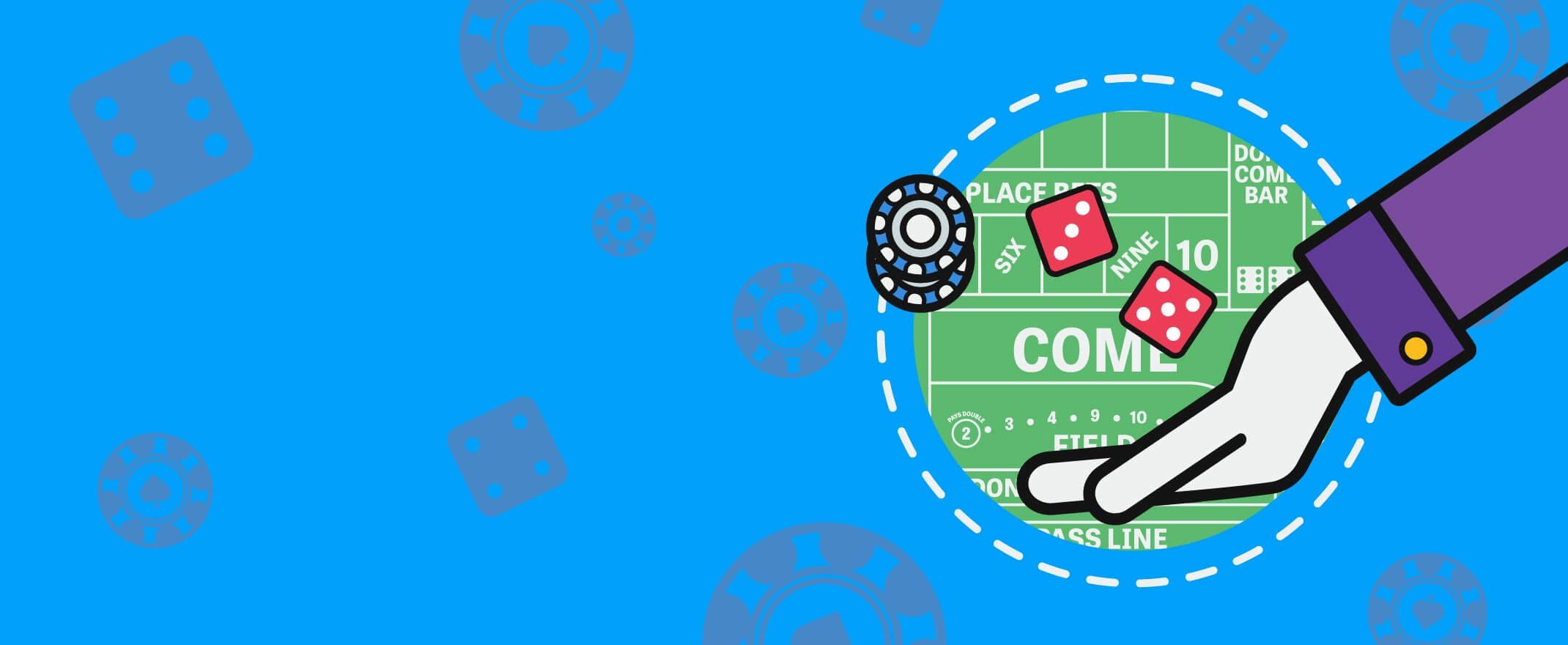In our guide below introduces a few different kinds of craps strategies, their advantages and their limitations. We will also be talking all about craps systems, what they have to offer the player and how they differ from strategies.
The difference between Craps systems and strategies
Craps systems and strategies act as guidelines for players who wish to organise their betting in a particular way. Of course, it is perfectly possible to enjoy yourself at the craps table without using either of these two and simply making your betting decisions one at a time. This is exactly what a lot of casual players do and it works out just fine for them.
In essence, a craps strategy is a series of actions that helps the player skew the odds in their favour and bring down the ever-present house edge. No strategy can completely get rid of the house edge, otherwise all those big casinos in Monaco, Macau and Vegas will have long gone bust. But there are bets that have a lower house edge than others and this is what strategies focus on.
Betting systems, on the other hand, act as a sort of ‘betting guide’. They outline which bets players should make, in what order and how many units to bet. Some systems involve higher risk than others but the choice of which system to follow ultimately lies with the player and depends on what they want out of their craps experience.
Craps strategy that actually works
It’s a good idea to be familiar with the concept of the house edge in any casino game as this tells you a lot about how likely you are to win or lose. Slots players, for example, are generally keen to know the RTP of a given slot game before they play for this exact reason.
There are a lot of possible bets one can make in a game of craps and it pays to know which ones have a higher or lower house edge and whether there are any actions you can take to shift it in the more advantageous direction.
By using a craps strategy, the player has a clear picture of the kinds of bets they should be making and the proportionate size of those bets.

Minimise the house edge
Craps has one of the broadest house edges spreads in any casino game. The house edge goes from under 2% at one end to north of 16% at the other extreme. The key to craps strategy is to make bets that have the lowest house edge.
The Pass/Don’t Pass line bets have the lowest house edge available in craps, at 1.41% and 1.36% respectively. This fundamental pair of bets is easy to understand and popular with all kinds of players because it is determined early on in the game. Both these bets pay out at 1:1.
Another way to take advantage of those small house edge values is the Free Bet. Now, in theory, the house edge on free bets is 0%. However! Free bets can only be made once a flat bet such as Pass/Don’t Pass or Come/Don’t Come has already been made. So technically, the player has already been exposed to the 1.41% or 1.36% house edge of those bets.
Free bets are sort of like doubling down in a blackjack game i.e. additional units are placed behind the first bet. Let’s take an example. The player places one unit on the Pass line and the shooter throws a point number. The player can then place a second unit behind the first and if the shooter rolls the point number, the player wins.
Free bets are paid at true odds. This means that the payout ratio matches the chances of the desired result occurring. If a result has a 2:1 chance of landing, the payout, if it does land, is also 2:1. This state of affairs is why the casino does not stand to profit from this kind of bet – it makes money by offering less than true odds.
Popular Craps systems
Now let’s take a closer look at craps systems. These offer players a ‘template’ for how to bet and how much to bet. This guidance can be appealing to new players but it is also important to consider how much inherent risk each system carries. High-risk play is unsuitable for inexperienced players because they risk losing their entire bankroll before seeing any return.
Why Craps systems don’t work
This is an odd thing to say isn’t it, especially in a guide to craps systems and strategies. But the truth is that following any of these craps systems is in no way a guarantee that you are going to win.
Gambling is entertaining and fun because it is unpredictable. It is that element of chance that makes games like craps, poker, slots and bingo so attractive. That randomness is always at play and it is important to remember that every roll of the dice in craps is a completely independent event. Roll number 10 is in no way influenced by roll number 9. Or five or two. Each time the shooter throws the dice, the game is ‘reset’.
Some games, such as blackjack and poker, can be said to have a memory i.e. once a specific card is played, it will not be returned to the pack until it is shuffled again so it cannot appear a second time. This is not true for craps, which only uses dice.
So what is the point of a craps system? A system can help players who find they benefit from having a structured plan to follow when betting. It can be easier to simply follow a system than to evaluate every single bet on every single round.
The objective of systems is, ostensibly, to see more wins than losses over the long-term. The actual range of what ‘long-term’ means is up for debate, so some players might see results sooner than others or not at all.
Next, we will be taking a look at some of the most popular craps systems available and how they work.

The Follow Craps System
This system relies on streaks. In a nutshell, the player simply bets the way the last decision went in hopes of it happening again. Now, we know that each roll of the dice is unaffected by any previous rolls so if the shooter just rolled two Fours in a row, the chance of rolling another Four is unchanged. However, streaks do happen and this system can be used to cash in on those.
Players can use the Follow Craps system on winning or losing streaks by making the appropriate Pass/Come or Don’t Pass/Don’t Come bets. When following this system, the player could be looking at changing their bets often so make sure you stay sharp so as not to miss anything as bets move around the table.
This system makes no attempts at choosing bets with lower house edge but luckily, the two pairs of bets in play have the lowest house edge values already.
Iron Cross Betting System
This system utilises a large swathe of the craps table. There are place bets on 5, 6, and 8, and a field bet, which covers 2, 3, 4, 9, 10, 11 and 12. Essentially, the player is betting on every number but the seven in this one-roll bet.
Of the 36 different possible dice combinations, the player can win on 30 of them, which is not insignificant. However, keep in mind that a loss can devastate your bankroll. In other words, you will probably win a lot of the time but a single loss will be big enough to put a serious dent in your winnings.
We know that the various numbers included in the Iron Cross bet have a different probability of landing and payouts, which makes estimating the house edge on the entire bet a little tricky. The house edge on this kind of bet comes in at about 2.37%, which is higher than its lowest-edge component (the place bets on 6 and 8, with 1.52%) and twice that of the Pass line bet.
Martingale Betting system
The Martingale betting system is possibly the most well known. It can be used in pretty much any gambling activity and is highly popular with roulette players in particular. It can also be applied to craps.
This system is very simple and relies on even money bets. In the case of craps, the Pass/Don’t Pass, Come/Don’t Come bets are excellent candidates. The player begins betting and every time they lose, they double the size of the bet. The idea is that through this progressive betting, earlier losses are overcome by a later, larger win.
As you can see, this system involves a significant amount of risk. Firstly, very few players have an unlimited bankroll that allows them to keep increasing their bets for a prolonged period. Another reason this system doesn’t work long-term is that casinos have betting limits. There is no way that, even with a bottomless bankroll, you could follow through with this system beyond a certain bet size.
Parity Hedge Betting system
At JohnSlots, we like to stick to the facts but we couldn’t leave out this bit of (completely fictional) craps folklore. The legend goes something like this. Some mathematicians, physicists and other assorted brainiacs once got together to come up with an algorithm to beat the craps table. This system was said to have been based on 11 key points, with bets offsetting one another.
These mysterious fellows tested their theory at the casino using small bets and playing at quiet periods to fly under the radar. Eventually, though, they enlisted the help of a Japanese businessman and avid gambler to really test the limit of the system. Long story short, the gambler won a lot of money but then disappeared, the suspected victim of the mob who ran the Vegas casinos.
If this sounds a little fantastical, that’s because it is. The whole story and the alleged betting system was cooked up by, of all things, a fraud awareness website.
Boozer’s Delight System
This simple system is popular with players who want to secure a seat at the craps table and watch the game. Some also point out that it’s a good way to keep the complimentary drinks coming but we don’t condone gambling when drunk so we’ll gloss over that part.
This system is best explained through an example. The player bets £5 on Pass and £15 on Don’t Pass. Once the point number is determined, the player lays £10 odds on the Pass.
If the point is 4 or 10 and the shooter lands it, the player wins £10. If the point is 5 or 9, the player wins £5 if the shooter lands it. If the point in 6 or 8, the player wins £2 if the shooter lands it. If the shooter lands a 7, the player loses nothing.
The player loses only when the come-out roll is 7, 11 or 12. If the shooter lands 2 or 3 on the come out, the player wins £10. This system doesn’t exactly pay big but its main aim is to keep the player involved in the game and to preserve as much of their bankroll as possible in order to do so.
3-Point Molly bet
The goal of this bet is to have three numbers on the go at the same time. This system aims to protect Pass bets while Come bets are being made. The bet is as follows:
- Player makes a Pass Line bet
- Player lays single or double odds behind the Pass bet
- Player makes a Come bet
- Player backs each Come bet with either single or double odds
- When the Come bet wins, the player places another
- Rinse and repeat until the shooter either makes the Point or Seven-Outs
Summary
Although craps is a game of luck, many players feel more confident at the table when armed with a betting system or strategy. While the former helps by offering a guide on how to bet, the latter makes use of the game’s built-in characteristics to make the smartest bet every time.

Frequently asked questions about Craps strategies
The basic rules of craps gameplay are fairly easy but when we venture into the territory of odds, house edge and the like, things get a little more complex. Below are some of the most frequently asked questions about craps.
What is the best strategy for Craps?
Craps strategy can be summed up very simply – make bets only on the outcomes that have the lowest house edge. While this may not be very exciting, particularly for risk-loving players, these outcomes do have the best chance of winning overall.
Do any strategies and betting systems really work in Craps?
As explained above, strategies use knowledge of the game’s house edge, payout values and odds to make smart betting choices. Betting systems, on the other hand, lay out which bets to make and at what size. These can be useful but it’s important to remember that no strategy can make up for the fact that every single roll of the dice is completely random and so, cannot be predicted.
Is Craps a game of skill or luck?
Craps dice throws are completely random so winning in craps is mainly dependent on luck. However, there is a level of skill in placing low house edge bets, so we would say it is a combination of both.
What bets have the lowest house edge in Craps?
The Pass and Come bets have a house edge of 1.41% while the Don’t Pass and Don’t Come bets have a house edge of 1.36%. These are the bets with the lowest house edge in craps.
Why should I bet pass line?
The Pass bet has the second-lowest house edge in craps (just behind the Don’t Pass bet). By placing a Pass bet, you are also indicating to the table that you are interested in taking on the role of shooter at a later stage.
Casino Game Specialist
6+ Years of Experience

Statistics
34 Articles
Harper Gallagher is a respected specialist in online casino games, particularly craps, poker and casino table games. By staying abreast of emerging technologies and trends, she inspires others to pursue their own passions in the exciting world of online casino gaming.
Expert On:


